Contents
The scaly white has the Latin name Hemistropharia albocrenulata. Its name was often changed, as they could not accurately determine the taxonomic affiliation. Therefore, it has acquired many designations:
- Agaricus albocrenulatus;
- Pholiota fusca;
- Hebeloma albocrenulatum;
- Pholiota albocrenulata;
- Hypodendrum albocrenulatum;
- Stropharia albocrenulata;
- Hemipholiota albocrenulata;
- Hemipholiota albocrenulata.

This species is one of 20 in the genus Hemistropharia. It is similar to the genus Foliot. The presence of scales on the body of mushrooms, growth on trees are common features of these taxa. Representatives of Hemistropharia differ at the cellular level in the absence of cystids and the color of basidiospores (darker). The fungus was discovered by American mycologist Charles Horton Peck in 1873.
What does the white flake look like
It owes its name to its appearance. The body of the fungus is completely covered with white scales. These growths disappear with time.
The smell of the flake belarus is muffled, sour, reminiscent of a radish with mushroom notes. The pulp is yellowish, fibrous, firm. It gets darker towards the bottom. Spores are brown, ellipsoidal in shape (size 10-16×5,5-7,5 microns).
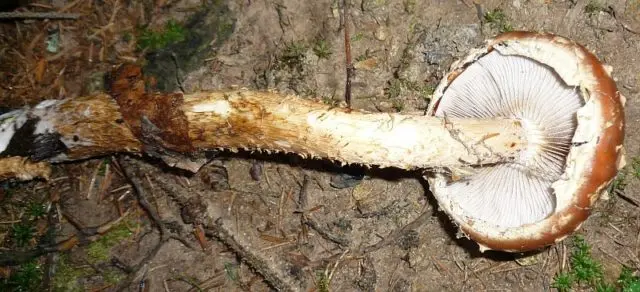
Young lamellae greyish-yellow. They are convex (as if flowing). With age, the plates become gray or gray-brown with a purple tint. The ribs become sharp, angular, more pronounced.
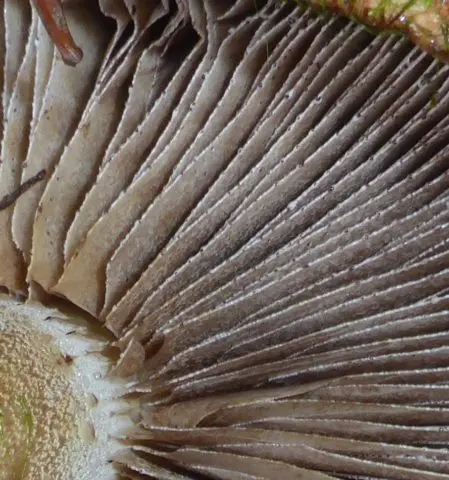
Cap Description
The diameter of the cap of the White-tailed Scale is from 4 to 10 cm. It is varied in shape. It can be domed, hemispherical or plano-convex. Characterized by a tubercle at the top. The color varies from brown to light mustard. The surface is dotted with triangular scales.
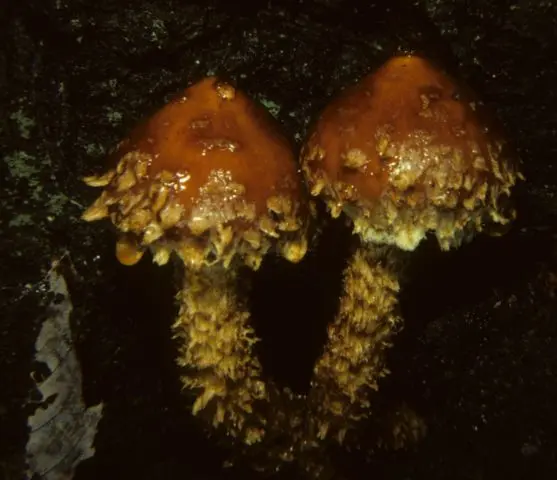
A torn veil is hung on the edge, folded inward. After rain or high humidity, the mushroom cap becomes shiny, covered with a thick layer of mucus.
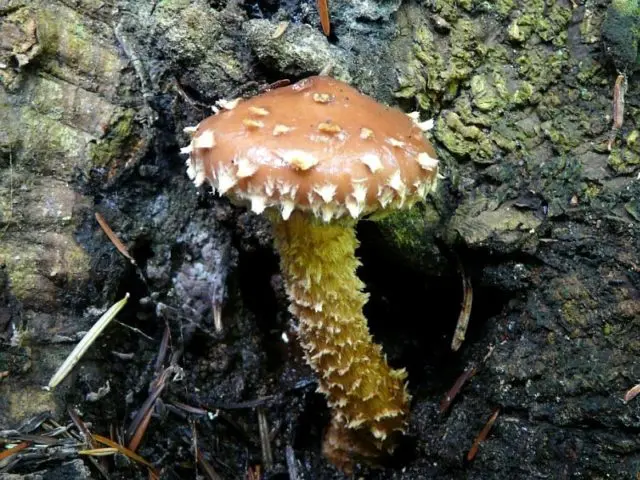
Description of the leg
Height up to 10 cm. Light shade due to the abundance of scales. The color of the legs between them is darker. Expands slightly towards the base. It has a noticeable annular zone (very fibrous). Above it, the surface acquires a corrugated texture. Over time, a cavity forms inside.
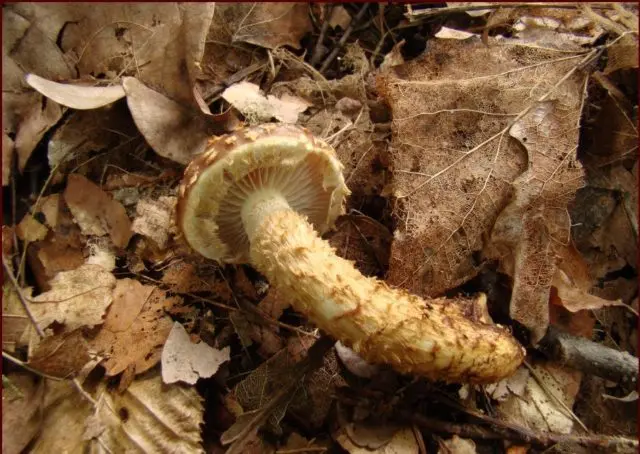
Is the mushroom edible or not?
White flake is not poisonous, but not edible either. It has a strong bitter, astringent taste.
Where and how to grow
This fungus is a phytosaprophage, meaning it feeds on the decay of other organisms. Grows on dead trees.
White flake can be found:
- in deciduous, mixed forests;
- in parks;
- near ponds;
- on stumps, roots;
- on dry land.
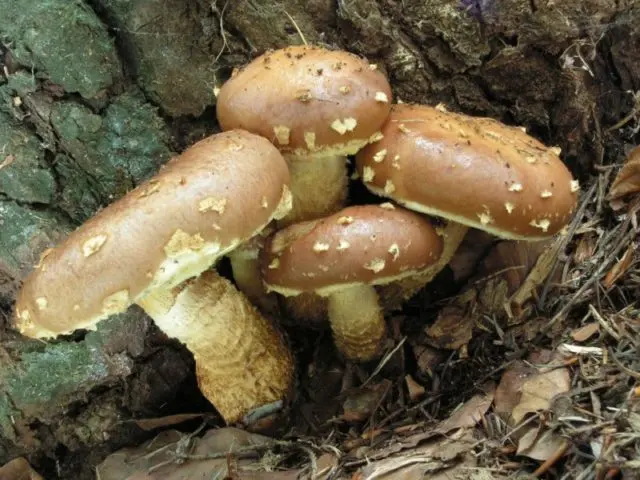
This mushroom prefers:
- poplars (mainly);
- aspen trees;
- beeches;
- spruce;
- oak trees
The white flake grows in Lower Bavaria, the Czech Republic, and Poland. Widespread in Our Country. The Far East, the European part, Eastern Siberia – everywhere you can find Hemistropharia albocrenulata. Appears in mid-spring.

Twins and their differences
Often mushrooms of different species and genera are outwardly similar to each other. Therefore, they are easy to confuse. White flake is no exception. You should remember the edible and poisonous counterparts of Stropharia white-headed.
Stropharia rugosoannulata
It also grows on organic waste. Is edible. But some complain of malaise and stomach pain when using it. So you should be careful when trying Stropharia wrinkled-annular. It differs from Scales in noticeable remnants of the velum, the absence of scales.
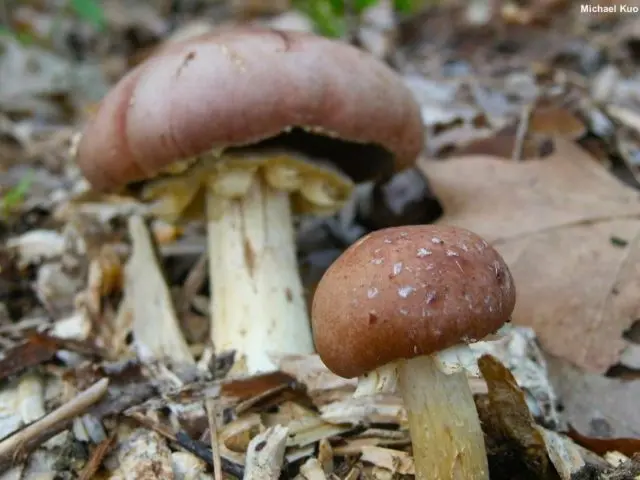
Stropharia hornemannii
Differs in pallor. There are no outgrowths and a mesh veil on the hat. Grows towards the end of summer. Stropharia Hornemann is toxic.
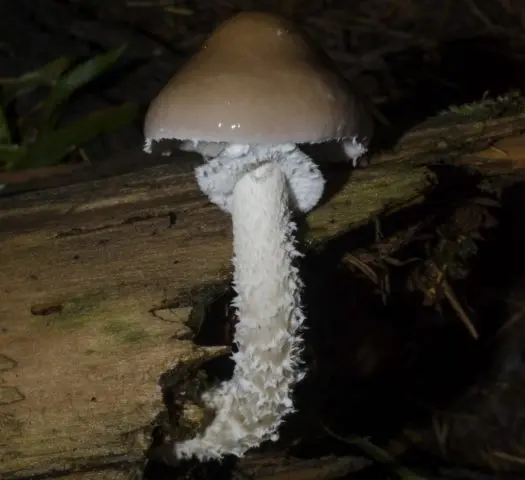
Pholiota adiposa
The flake is thick and colored yellow. She has rusty scales. The smell is woody. It is not edible because it is bitter.

Conclusion
White flake is considered a rare mushroom. It is under the protection of many countries. It is included in the register of protected and endangered species in Poland. In the Federation, it also has a special status. For example, it is in the red book of the Novgorod region marked “vulnerable”.
Therefore, treat the White-Cutted Scale with care if you meet it in the forest.









